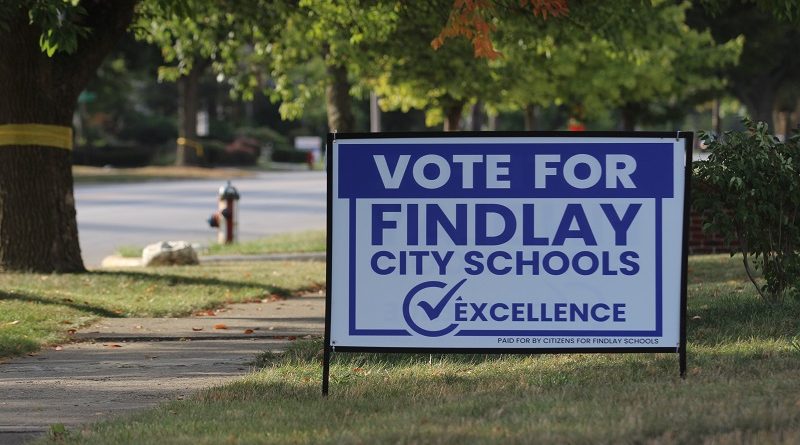Voters To Decide On Findlay City Schools Income Tax Levy
Findlay City Schools will have an income tax levy on the fall ballot.
On November 5th, voters in the school district will decide whether to approve a 1 percent earned income tax levy for the purpose of paying current expenses.
The school district points out that it has not received any new operating funds for almost 20 years and property tax funds don’t go as far as they used to and it will see a reduction in state funding next school year.
“Investing in our schools is investing in our community’s future. The Findlay City Schools Board of Education voted to place a 1 percent earned income tax issue on the November 5, 2024 ballot to keep Findlay City Schools excellent. The district has extended the last new operating levy 19.5 years, which means they are paying 2024 bills with 2004 dollars,” according to the website voteforfindlayschools.com which has plenty of information about why the levy is necessary.
Superintendent Dr. Andy Hatton points out that an earned income tax levy will not impact things like social security and pensions as a traditional tax would.
Findlay City Schools says it will begin running a deficit this year and expects its cash balance to run negative in fiscal year 2026 if a levy isn’t passed.
The school board said this is the best mechanism to proceed to get new operating revenue into the district because it is earned income tax and it will grow with inflation and won’t be held flat like property tax.
The Findlay City Schools Board of Education says an exceptional school district is essential to the vibrancy of Findlay. It attracts new businesses, fosters economic growth, and upholds the high standards the city is known for. A strong education system is a key component of the community’s long-term prosperity. Findlay prides itself on being a place where families want to live, businesses want to invest, and children are provided with the best opportunities for success. The Findlay City School District has achieved a high standard of education that has been vital to families and the community’s continued growth and success.
Increasing FCS’s revenue is vital to ensuring that the excellence of Findlay City Schools continues to deliver educational quality for parents and drive the community forward.
Maintaining Excellence in Challenging Times: Findlay City Schools struggles to keep pace with growing expenses as inflation outpaces revenue growth. Like most school districts, Findlay City Schools receives mostly flat funding from the State of Ohio based on the most recent state budget from Ohio’s school funding model. This requires the District to rely on the community through voter-approved levies to help offset inflation and sustain operations.
Findlay City Schools has stretched local tax support for nearly twenty years, with the last operating levy passed in November 2004. This has led Findlay Schools to have one of the lowest current residential tax costs in the region. The new state funding formula indicates Findlay has a greater local ability to support a larger portion of the funds needed to educate our students than is currently being generated. The new state funding formula looks at a community’s ability to support local schools using both property and income tax and then determines state support to augment the local ability to generate funding. State funding will not be increased to compensate for lack of funding at the local level.
Full Transparency and Expert Consultation: To ensure the community receives accurate, objective, and verifiable information, the district has brought in a consultant with expertise in school finance sustainability. This consultant has been working with the team to clearly communicate the urgency and validity of the need for additional operating funding. By providing expert insights, the district is committed to transparency and accountability in demonstrating why this levy is critical and creating a tax policy.
The Need: Findlay City Schools needs to increase their operating income to sustain the current level of excellence and quality of education. The finance team, working with the Board and its finance expert, determined a 1.00% earned income tax will deliver an increase in revenue that will not only meet the current needs of the District but carry it forward for the foreseeable future.
The Critical Role of the 1.00% “Earned” Income Tax: The revenue generated by this levy is essential to sustaining the educational excellence that the community values. It supports programs, services, and rising operating costs, ensuring students continue to receive the high-quality education that is key to their success. It also supports the District’s long-term goal to become financially sustainable over longer periods of time, as well as providing tax relief to residents who are on fixed incomes, retired, or soon to be retired. An “earned” income tax is specifically designed to minimize the future cost of taxes to our community’s older residents.
Impact of Levy Failure: If the levy is not approved, a first phase of immediate reductions will need to be implemented, continuing into the 2025-26 school year. These cuts will negatively affect the district’s ability to maintain its current level of excellence in programs and opportunities, directly impacting students and families.
The Board of Education will have to enact the following likely consequences:
Phase One: Initially Proposed Reductions (School Year 25-26):
Reduce staff by 27 teaching positions, including Teachers on Special Assignments, using a combination of average salaries since the reductions will be in the future and by not replacing projected five retirees.
Reduce additional 12 staff by eliminating Middle School Block Teaching for Math and Language Arts
A minimum of five administrators will be reduced.
Athletic supplementals and non-athletic supplementals will be reduced
Cutting the purchased service expenditures related to the Leader in Me Program and reducing professional development.
Reduce Kindergarten staff by returning to half day kindergarten
No busing to high school and maximum amounts for walking
Reduce 15 support staff positions
These likely reductions are subject to change based on retirements and resignations, changes to enrollment, or other circumstances.
Phase Two Proposed Reductions (School Year 26-27):
Should the Board continue to be unsuccessful in securing additional operating funding, a second round of likely cuts would need to be implemented in FY27, of an additional 4 million dollars.
Reduce the teaching staff up to additional 26 positions
Reduce up to an additional 25 supplemental positions
Reduce up to an additional 4 administrative positions
Reduce security guards by up to 8 positions
Close all buildings by 6:00 p.m. and end busing to all events
Reduce support staff by up to 10 positions

